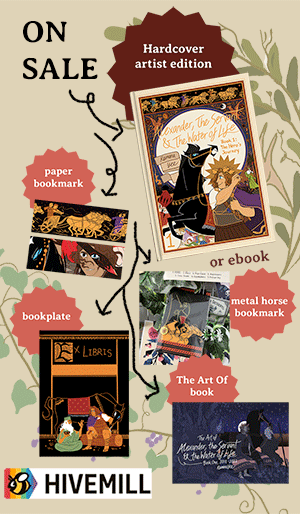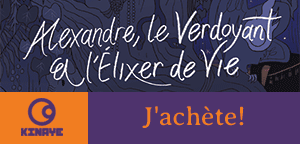Writing
Another really short chapter to balance out the length of the previous story. This Olympic Games premise is entirely made-up, as it never historically happened EXCEPT as an episode in the Alexander Romance legends (Book 1, Chapters 18 - 20) , immediately following the Taming of Bucephalus story.
It's definitely a Choice to feature this particular fiction when the Romance also includes other fake stories like Alexander being stuck in an all-night battle with a bestiary, his visit to the talking trees and his war with the fairies. Those will be in the comic eventually... but I found the Olympics story a really good opportunity to develop some more character, again with the competitive dynamic between Alexander and his father, his meh attitude towards sports, his relationship with Hephaestion and the budding of his need for conquest...
while introducing another metafictional aspect hinted at in the Prologue and Chapter 3: how would the subject himself react to all of these legends?
Exaggerated stories and gossips of flattery are endemic to royal celebrity. And Alexander himself wouldn't be resistant to the allure of them. Afterall, this is the guy who mostly believed himself to be the Son of God just because someone said so (helps that it also conveniently legitimised his power in the eyes of his newfound subjects of Egypt and Mesopotamia). A personal Olympic win is incorrect, but does it matter? Does it make a difference? Especially if it's a hit story that makes you look awesome to the peasants?
All who wrote about Alexander preferred the marvelous to the true. (Strabo, Geography)
The Rule of Cool applies to ancient propaganda.
The Servant here is taking on the role of an uncritical audience - or simply, a typical modern-day uncle cursed by Whatsapp chats - who trust hearsay and like these fanciful anecdotes. Or people like me months ago with an amateur's understanding of the context, to not realise that a Greek king of Alexander's time personally competing in the Olympic chariot race was way below their rank.
Chapters 4 follows more or less the sequence in the original Romance version. Alexander wants to go to the Olympics, he brings along Hephaestion (this story is also the only time in the original Romance where Hephaestion makes a named appearance), during a trip around town they meet a jerk...
Chapter 5 will continue from that point, on the actual chariot race itself.
Thumbnailing and Sketching
Tools
Thumbnails: Moleskine notebook, mechanical pencil
Sketches: Procreate, iPad with Apple pencil
Time taken
Thumbnails: 15 minutes.
Sketches: (not counting breaks) 2 days, approximately.
Inking and Colouring

I add dialogue on top of the sketches before moving on to the inks (or colours in this case). This is so speech bubbles are better integrated into the layout of the panels, and issues with spacing and composition are fixed. Nobody wants to squeeze a too-big bubble into a tiny space in post!
Tools
Inks: Procreate, iPad with Apple pencil
Colours and Letters: ipad, Procreate, Photoshop
Time taken
Inks: There was no inking involved besides the four pages in the middle. Those took a day and a half.
Colours: A week. One spread took one day, more or less.
I worked on each half in 4-day bursts, separated by a week and a half's break.
Research
Research is mostly concentrated on art direction and material culture (the parts that are not anachronistic).The style of the "flashbacks" is a mix of red and black figure pottery, primarily in the Kerch style. The Kerch style is a variant of red-figure that featured multicolour paint and gold foil on clothing, and is contemporary to Alexander's era, beginning in 375 BCE and dying out in 320 BCE).
I wanted to adapt ancient Greek pottery art in a way that's fresh, but still true to the original. Fortunately, my natural style is already very close to the ancient Greek way of drawing (whether that's a good or bad thing, I don't know lol), so it didn't take much effort to tweak my style accordingly.
The most important thing about ancient Greek pottery art is that, like all limited-colour flat lineless art based on silhouette, it requires some planning. You don't want to accidentally complicate the composition - it has to be clear, easy to read and concise. Afterall, these were originally product designs meant for material goods, and it has to depict a story/scenario on top of that. The customer has to know what's going on in the vase they are buying, and the kind of status/value the vase represents beyond its practical usage. And how do they get this information? From the drawings. In that regard, ancient Greek pottery is closer to illustration and product design.
I didn't want to stick to just a red or black figure. I went with a mix, choosing to approach everything like the UPA style of animation with stylised graphics and colour grouping (see Disney's Rhapsody in Blue). Black figures are contained within red figures. Crowds and objects are grouped into red or black, with the main characters being in full Kerch colour. Colours are layered according to composition.
Googling modern takes of ancient Greek art brings up a solid bunch of examples, but the thing I've noticed most of them not doing is honouring the hand-drawn, wobbly, wonky aspect of the linework. A lot of these takes have clean, straight, precise, almost angular, symmetrical lines. But if you look at the original pottery closely you'd see how wonky the lines are. Which makes sense, because these were painted by hand. There's charm. There's an awkwardness that comes from an artist not drawing something properly, either by accident or on purpose. So rather than being so meticulous with my linework, I went loose.
Normally I'd hand-draw my sketches and inks and afterwards go though an almost-mindless, meditative process of dropping colours with the Fill Bucket tool, with additional hand-drawing for the details and decorative elements. But for this Chapter and the next, I hand-drew and hand-painted everything. It's the same process I used for my other graphic novel, Seance Tea Party. I've already described my process and art direction for that particular book on Twitter and in my blog and at the back of the book. That process is a bit of a pain, like, literally, because it actually puts more strain on my hand for some reason. But the end result is always charming, which is the goal.

A page in the middle of being painted. Procreate app on iPad.

A better view of the Kerch style test. Alexander laughs at Hephaestion's teasing as they hurry off hand-in-hand to the races, their horses beside them.






